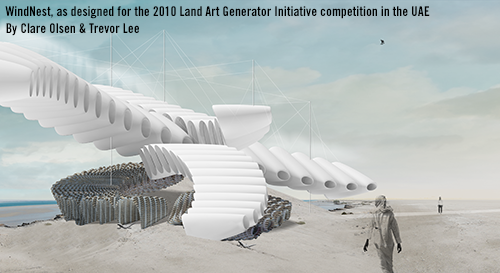
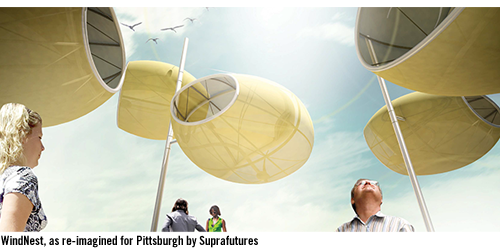
We are very pleased to announce that two of Pittsburgh’s preeminent foundations, Heinz Endowments* and the Hillman Foundation, along with the Horne Family Foundation, have awarded grants to support the schematic design and prototyping stage of the WindNest project (a LAGI 2010 proposal by Trevor Lee and Clare Olsen). WindNest will be the very first land art generator to be constructed. By integrating wind and solar technologies as the medium for the artwork, WindNest will pay back its embodied carbon footprint and its construction cost through the clean megawatt-hours that are a product of its performance, while also delivering on all of the traditional economic stimulus and placemaking benefits of public art.
The pragmatic and performative aspects of WindNest are provided through two means of energy collection. Each of the artwork’s cloud formations is fitted with a ducted wind turbine. In addition, one third of the surfaces are covered with solar fabric.
The proposal utilizes low-impact, lightweight materials chosen in consideration of the full life-cycle of the project from material production to construction, maintenance and even after its role as a public art installation. The wind-tunnel tested tensegrity structure will utilize UV resistant TENARA® (Teflon) fibers, which are extremely thin to give the work an ethereal and lightweight presence. The project is designed to be easily dismantled and updated with replacement technology.
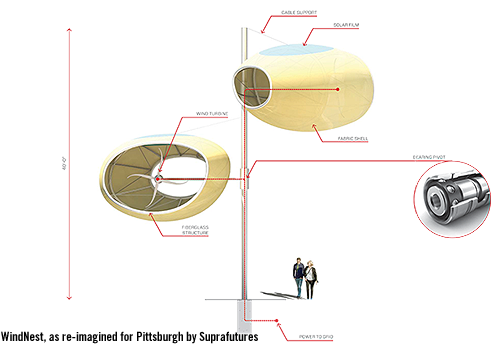
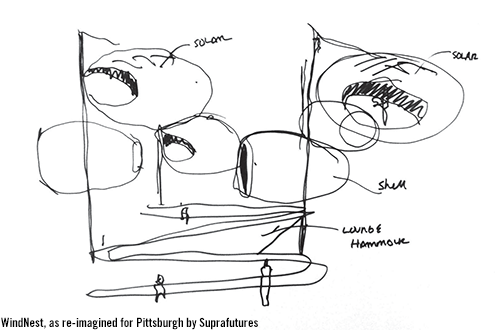
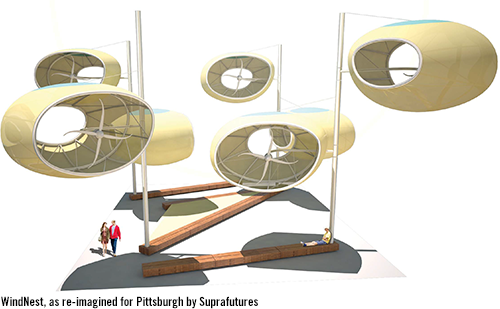
Scaled for the Pittsburgh sites, WindNest will be designed to generate approximately 150MWh per year, or enough to offset the electricity used by 20 homes.
More than just a public artwork, WindNest will become a living technology, art, and science lab. Interactive educational programming will be designed into the sites with environmental graphic design and real-time data visualizations that will explain the project clearly to the audience.
WindNest will present a model for what renewable energy generation can aspire to be within urban landscapes and will provide:
- City Beautification: All of the traditional benefits of public art
- Education: WindNest will provide a place for the community to learn about sustainable systems and to see renewable energy in action
- Healthy Environment: CO2 emissions reduction from WindNest
- Sustainable Resource: generate megawatt-hours of electricity each year, which can be sold back to the utility grid, thus offsetting the electricity use of the site owners and lowering their carbon footprints
- Healthy Communities: people coming together to support sustainable development
- Economic Development: WindNest will bring positive attention to the city and increase foot traffic within the vicinity of its sites
- Innovation: Interdisciplinary collaboration drives technological creativity
- WindNest will be a symbol of Pittsburgh’s commitment to a green economy
*The Heinz Endowments supports efforts to make southwestern Pennsylvania a premier place to live and work, a center for learning and educational excellence, and a region that embraces diversity and inclusion.
The Land Art Generator Initiative is pleased to be working with the design team behind WindNest.
SUPRAFUTURES partners Clare Olsen & Trevor Lee bring years of experience in design, project management, and fabrication of work at a wide range of scales.

CLARE J. OLSEN
Designer & Partner, SUPRAFUTURES
Clare Olsen holds a Bachelor of Arts in Environmental Studies from Brown University and a Masters of Architecture from the University of California Los Angeles. At UCLA she studied with numerous progressive educators including Greg Lynn, with whom she completed a year-long research project. In Los Angeles and Stockholm, Olsen worked for servo on “lobbiports” and “lattice archipelogics”, which were exhibited in New York City and Graz, Austria respectively. These experiences with servo influenced Olsen’s affinity with installation-scale projects. With her firm, C.O.CO., she designed and fabricated a permanent exterior installation for Syracuse University entitled “PROJECTions” and a semi-permanent sculptural piece entitled “Reflection” in the grand staircase of the Robert Kennedy Library at Cal Poly San Luis Obispo. Olsen is also co-founder and Partner of SUPRAFUTURES, a multidisciplinary, ecologicallyminded design firm working at a range of scales.
Olsen’s professional work also includes several years at Kanner Architects in Los Angeles. As Project Manager on the United Oil station, she took the project from Design Development through Construction Documents, pulled 20 permits for the project and started Construction Administration before moving to New Orleans to teach at Tulane University shortly after hurricane Katrina. Olsen is a dedicated educator and has also taught at Syracuse University, Cornell University and currently holds an Assistant Professor position at California Polytechnic State University in San Luis Obispo.
TREVOR LEE
Landscape Architect & Partner, SUPRAFUTURES
Trevor holds a Masters of Landscape Architecture from the Rhode Island School of Design and a Bachelor of Fine Art from the Massachusetts College of Art. He has over twelve years of experience working both in the private and academic sectors. He brings a wealth of public realm and urban planning expertise as well as strategic leadership and project management experience to any project. Trevor is currently a Partner and co-founder of SUPRAFUTURES, a multidisciplinary landscape and architecture office. Trevor also works full time with OLIN in Philadelphia as the Manager of Visual Communications.
In his previous position as Associate at James Corner Field Operations, he led the concept phase of The High Line section 3 and the winning competition entry for Chicago’s Navy Pier. He also led the design of the Central Green in Philadelphia’s Navy Yard and was a senior designer for the Tsim Tsha Tsui waterfront in Hong Kong, a waterfront nearly 1 mile in length.
Prior to his working with JCFO, Trevor completed a two-year fellowship with UPSTATE: at Syracuse University’s School of Architecture, where he led studios focusing on the post-industrial landscape. He has taught studios at the University of Pennsylvania and worked with the artist Michael Singer, Landscape Architect Martha Schwartz Partners and with OLIN as a Senior Landscape Designer in Philadelphia. While at OLIN, Trevor led the design team for the Yale University Forestry School Landscape, a LEED platinum project. He also was the lead designer for the Potomac Park Levee project in Washington D.C.
Trevor was one of four finalists for the Rome Prize in Landscape Architecture for 2013.

Related Posts
1 Comment
Add comment Cancel reply
This site uses Akismet to reduce spam. Learn how your comment data is processed.

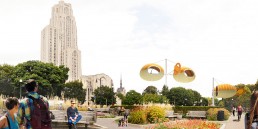
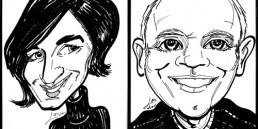
[…] Windnest in Pittsburgh, the Green Loop, in New York […]